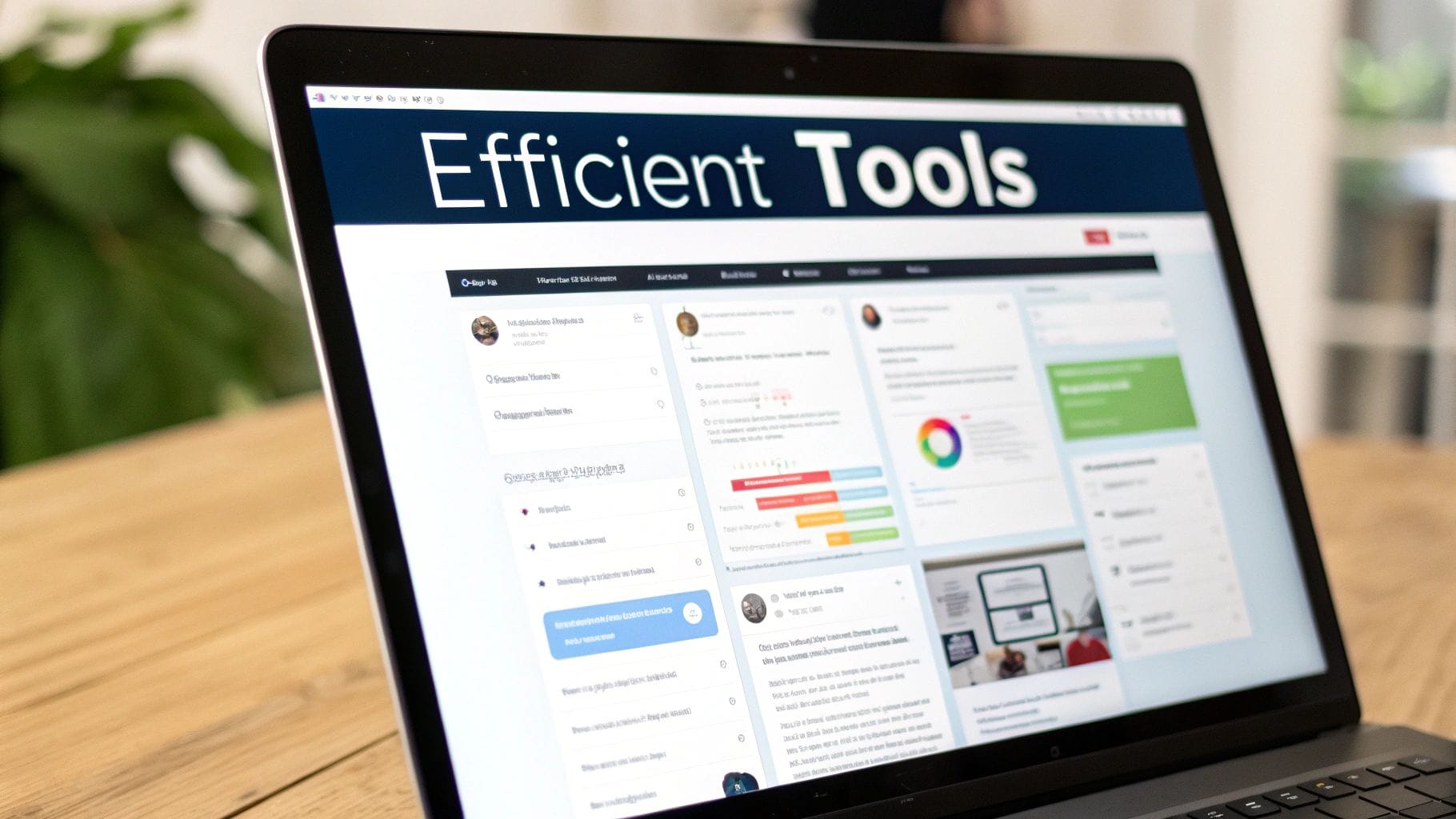Internal Communications Best Practices: Transform Employee Engagement Through Proven Strategies
Internal Communications Best Practices: Transform Employee Engagement Through Proven Strategies
Building Trust Through Transparent Communication

Clear and direct communication builds the foundation of successful organizations. When companies prioritize sharing information openly with employees, they create an environment of mutual trust and respect. This section explores specific ways that transparent communication practices strengthen employee engagement and create a more productive workplace.
Why Transparency Matters in Internal Communications
When leaders communicate openly with employees, they build credibility and prevent harmful speculation. Regular updates about company performance, challenges, and future direction give employees context for their work and help them feel invested in the organization's success. For example, when executives share quarterly results and explain how different teams contributed, employees better understand their role in achieving company goals. This kind of transparency shows respect for employees' need to know how their work matters.
Practical Steps to Enhance Transparency
Creating transparent communication requires both the right tools and the right culture. Start by setting up clear channels like regular town halls, online discussion forums, and internal social networks where employees can easily share information and ask questions. But having these platforms isn't enough - leaders need to actively encourage participation by showing they value employee input. This means creating an environment where people feel safe raising concerns or offering feedback without fear of negative consequences.
Structuring Effective Town Hall Meetings
Town halls give leaders a chance to connect directly with employees, share important updates, and answer questions in real-time. The key is designing relevant agendas that address what employees care about most - like current performance, upcoming projects, and industry trends. Include both pre-submitted and live Q&A segments to enable real dialogue. This shows commitment to hearing employee perspectives. For more tips on engaging employees, check out our guide on How to master your company newsletter.
Simplifying Complex Information
Often, internal messages involve explaining complicated topics. The best approach is to break down complex ideas without losing important details. Use clear language, avoid unnecessary jargon, and add helpful visuals like charts to make information easier to understand. Taking time to explain the reasons behind decisions helps employees grasp the bigger picture. When employees understand both what is happening and why, they're more likely to support new initiatives. Keeping messages consistent across different communication channels also prevents confusion and helps reinforce key points.
Mastering Digital Communication Tools That Work
Good communication needs more than just the right message - it needs the right tools to deliver it effectively. Organizations must thoughtfully select and implement digital platforms that truly support their teams' collaboration needs while maintaining genuine human connection. Here's how to build a digital communication strategy that works.
Selecting the Right Tools for Your Needs
Different communication challenges require different solutions. Before adopting new tools, carefully assess your organization's specific needs. If teams are struggling to find and share information, a well-designed intranet could help break down silos. For quick collaboration, platforms like Slack or Microsoft Teams might be the answer. The key is choosing tools that make work easier, not harder. If email remains your primary channel, you may find these tips helpful: How to master email deliverability.
Creating Inclusive Digital Environments
Your digital workspace should be accessible to everyone, regardless of technical ability, location, or needs. This means providing thorough training and support to help all employees participate fully. Think of it like building accessibility into physical spaces - your digital tools need features like screen readers and language options to ensure no one is left out. Regular check-ins and feedback help identify and address any barriers to participation.
Maintaining Human Connection in a Digital World
While digital tools enable efficient communication, they shouldn't replace meaningful human interaction. Balance asynchronous tools like email and chat with synchronous connection through video calls and virtual team activities. Something as simple as turning on video during meetings can help maintain personal bonds between remote colleagues. The goal is using technology to enhance, not replace, authentic workplace relationships.
Recognizing When Your Digital Strategy Needs Adjustment
Like any business approach, your communication tools and practices need regular evaluation. Watch for signs that your current setup isn't serving your teams well - low engagement, confusion about which tools to use, or people creating unofficial channels to get work done. Gather feedback through surveys and conversations to understand what's working and what needs to change. With ongoing monitoring and willingness to adapt, you can ensure your digital tools truly support collaboration and workplace culture.
Creating Leadership Communication That Resonates

Good leadership communication goes beyond simply sharing information - it creates real connections and motivates people to take action. When leaders communicate in ways that personally resonate with employees, it builds engagement and shapes a positive workplace culture. This means moving past formal announcements to have honest, open conversations.
Increasing Leadership Visibility
Leaders need to be visible to employees, but quality matters more than quantity. Rather than overwhelming staff with constant messages, focus on meaningful interactions that show you genuinely care about their work and wellbeing. For example, instead of relying only on email updates, try sharing video messages for important announcements to make them more personal. Taking part in team meetings or hosting casual Q&A sessions also helps bridge the gap between executives and frontline staff while building stronger connections.
Crafting Messages That Connect
How leaders deliver their message is just as crucial as what they say. Authenticity is essential since employees can easily spot corporate jargon that feels fake. The most effective leaders communicate clearly and empathetically in their own voice. They explain the reasoning behind decisions, show how each person's role supports bigger company goals, and recognize people's contributions. Think of it like a coach giving their team a pep talk - providing context, motivation and a clear vision of success. Learn more about engaging communications in our article on How to write the best newsletter subject lines.
Maintaining Consistent Communication During Challenging Times
Clear, consistent communication becomes even more important during periods of change or uncertainty. When challenges arise, speculation and anxiety often increase among employees. Leaders can reduce these concerns through proactive, transparent updates. Even if they don't have all the answers yet, regular communication shows that leaders are actively managing the situation and keeping everyone informed. This builds trust and reinforces that everyone is working through challenges together.
Bridging the Gap Between Leadership and Employees
Connecting executive leadership with frontline employees requires deliberate effort through multiple approaches. Consider strategies like:
- Regular "Ask Me Anything" sessions: These create opportunities for employees to directly engage with leaders on any topic, promoting transparency and open dialogue.
- Leadership spotlights: Featuring individual leaders in company newsletters or intranet posts helps employees learn about their background, values and leadership approach, making executives more relatable.
- Reverse mentoring programs: Pairing senior leaders with junior staff on projects creates learning opportunities for both sides and breaks down hierarchical barriers.
- Skip-level meetings: When leaders meet with employees two or more levels below them, it provides valuable insights into front-line perspectives and challenges.
By putting these communication practices into action, organizations can build a culture of openness, trust and shared understanding that boosts employee engagement, productivity and overall success.
Developing Feedback Systems People Actually Use

Good internal communications rely on more than just pushing information out - they need meaningful two-way dialogue. Many companies still depend on outdated methods like yearly surveys and suggestion boxes that gather dust. To create truly effective feedback systems, organizations must build channels that employees find valuable and want to use regularly. When people feel heard, they become more engaged and perform better.
Why Traditional Feedback Methods Often Fail
The standard approach of conducting annual employee surveys typically falls short because it's too infrequent and impersonal. More importantly, employees rarely see concrete changes result from their input. It's like speaking into an empty room - you put in effort but get nothing back. These one-size-fits-all methods also miss important nuances in how different employees experience the workplace.
Designing Feedback Systems for the Modern Workplace
To build feedback systems that work, start by creating an environment where people feel safe speaking up. This means leaders must clearly communicate that honest input is welcome and valued, without fear of negative consequences. For instance, managers can build trust by openly discussing feedback received during team meetings and explaining how they'll act on it. When employees see their ideas being taken seriously, they're more likely to keep sharing.
Utilizing a Variety of Feedback Channels
Different employees prefer different ways of sharing input, so offer multiple options. While surveys help collect broad data, complement them with focus groups and one-on-one discussions to dig deeper. Anonymous channels can also encourage people to raise sensitive concerns they might hesitate to bring up otherwise. For more strategies on gathering employee input, check out: How to improve email engagement.
Turning Feedback Into Action: The Key to Success
The most important part of any feedback system is showing employees that their input leads to real changes. This completion of the feedback loop proves that speaking up makes a difference. Consider creating a dedicated team to review suggestions, set realistic timelines for implementing changes, and keep everyone updated on progress. When people see their ideas becoming reality, they'll be more motivated to participate in future feedback efforts.
Building a Culture of Continuous Feedback
Effective feedback should be an ongoing conversation, not a once-a-year event. Regular check-ins with employees, both individually and in groups, help spot issues and opportunities early. This consistent dialogue builds stronger relationships between employees and the organization. The goal is to make feedback a natural part of how work gets done, rather than a dreaded task. With the right approach, feedback becomes a powerful tool for growth and higher engagement.
Measuring What Actually Matters in Communication
When it comes to internal communication, success isn't just about getting messages out - it's about creating real connections that engage employees and drive results. But measuring communication effectiveness can be tricky. While metrics like email open rates provide basic data, they don't tell us if our messages are actually making an impact. To truly gauge success, we need to look at how communication influences key business outcomes.
Moving Beyond Surface-Level Metrics
Email open rates and click tracking only scratch the surface. A high open rate doesn't necessarily mean employees understood or acted on the information. To get the full picture, we need to examine how communication practices shape employee behavior and help achieve organizational goals. This requires looking at deeper indicators of success.
Key Metrics for Meaningful Measurement
Here are the essential areas to measure:
Message Reach and Understanding: Regular surveys, quizzes and focus groups can reveal if employees are receiving and comprehending important communications. This helps identify where messages need more clarity.
Employee Participation: Track not just the quantity but quality of engagement in town halls, feedback sessions, and online discussions. Look for signs of active involvement versus passive consumption.
Action and Implementation: Monitor if communications drive desired changes. For example, measure adoption rates for new policies or completion rates for training programs.
Business Results: Examine connections between communication effectiveness and key performance metrics like productivity, customer satisfaction scores, and employee retention.
Cultural Impact: Use surveys and feedback tools to assess how communication practices influence employee satisfaction and workplace culture.
Practical Tools and Methods
Several approaches can provide valuable measurement insights:
Communication Audits: Regular audits offer a thorough review of what's working and what needs improvement in your communication strategy.
Employee Feedback: Anonymous surveys create a safe space for honest input about communication effectiveness. Include both rating scales and open-ended questions.
Analytics Tools: Use data platforms to track key metrics across channels and spot important patterns and trends.
Focus Group Discussions: Small group sessions allow for deeper exploration of specific communication challenges and solutions.
The key is to make measurement an ongoing cycle of learning and refinement. By tracking meaningful metrics and analyzing the results, organizations can strengthen their communication practices, prove value to leadership, and build stronger workplace connections. You might be interested in: How to master newsletter best practices to further improve your communication approach.
Creating Communication Strategies That Drive Results

Building effective internal communications takes more than basic emails and meetings. Success comes from carefully aligning your communication efforts with your company's core goals and needs. This means getting to know your people, crafting messages that connect, and being ready for both planned updates and unexpected challenges. When done right, your communications actively move your organization forward.
Defining Your Target Audience and Objectives
Just like marketing to customers, understanding your internal audience is essential. Start by looking at your employees' different roles, teams, locations and how they prefer to receive information. This helps you shape relevant messages for each group. For instance, technical updates work well as brief emails to engineering teams, while company news often deserves a town hall meeting where everyone can participate.
Being selective about what you share with each group prevents information overload. It's also important to set clear goals for your communications. Ask yourself: What do you want people to know or do differently after receiving your message? Your communication objectives should directly support business priorities, whether that's increasing product knowledge, getting people to use new tools, or improving how teams work together.
Developing Key Messages and Choosing the Right Channels
After understanding your audience and goals, focus on creating clear, memorable messages that support those aims. Think of these as the main points you want people to remember and act on. Keep your key messages consistent across all your communications to build understanding and avoid confusion. Use straightforward language that your specific audience will connect with, steering clear of unnecessary jargon.
The right communication channel depends on both your message and who needs to receive it. While email works well for formal announcements, tools like Slack or Microsoft Teams are better for quick team discussions. Your company intranet can serve as a central information hub, and video meetings add a personal touch for important conversations. Rather than relying on just one method, use multiple channels strategically to reach people effectively.
Planning for Crisis Communication and Measuring Results
Even with careful planning, unexpected situations will arise. Having a solid crisis communication plan helps you handle challenging times smoothly. Your plan should identify who speaks for the company, set clear protocols, and outline key messages for different scenarios. This preparation helps you communicate quickly and openly during difficult periods, which maintains trust and reduces confusion.
Finally, track how well your communications work so you can keep improving. Look at metrics like how many people you reach, how they engage with messages, and their feedback on clarity. These insights help you refine your approach, understand what resonates, and show leadership the value of strong internal communications. Just as marketing teams analyze their campaigns, regular evaluation helps you maximize the impact of your internal communications.
Ready to transform your internal newsletter into a powerful engagement tool? Inagiffy provides an end-to-end newsletter service that takes care of everything from content creation and server optimization to readership growth, ensuring your internal communications deliver measurable results. Learn more about Inagiffy.